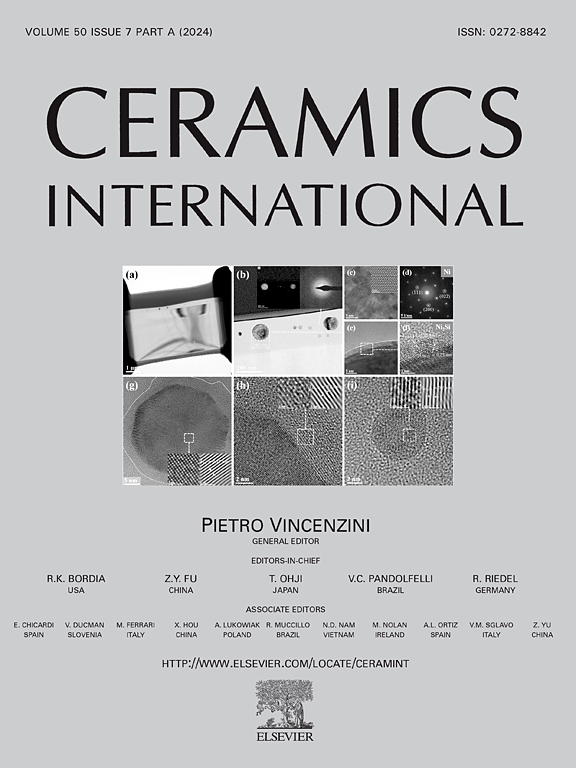Rheological properties of SiO2-CaO-MgO-Al2O3-(0-30 wt%)B2O3 system at basicity 1.4: Experiment and modelling
IF 5.6
2区 材料科学
Q1 MATERIALS SCIENCE, CERAMICS
引用次数: 0
Abstract
Boron oxide (B2O3) affects the viscosity and phase change temperatures of glasses and melts, which are widely used in various industrial processes. In this study, the effect of B2O3 in a wide concentration range (0–30 wt%) on the melting and rheological characteristics of the oxide system SiO2(37.7–25.2 wt%)-CaO(42.8–25.3 wt%)-MgO(10 wt%)-Al2O3(9.5 wt%)-B2O3(0–30 wt%) with a constant basicity of 1.4 was studied experimentally and theoretically. The experimental rheological data measured with a high-temperature rheometer up to 1550 °C were supported by the study of the internal structure by an X-ray powder diffraction analysis (XRPD), scanning electron microscopy with an energy-dispersive X-ray spectroscopy (SEM/EDX), a Fourier transform infrared spectroscopy (FTIR) and Raman microspectroscopy. The increase in the B2O3 content in the samples caused a dramatic decrease in the softening and liquidus temperatures. Up to 15 wt% B2O3 content, it was possible to determine the break temperature, which decreased with increasing B2O3 content. The exponential decrease in dynamic viscosity with an increasing temperature and its decrease with an increasing B2O3 content was caused by the decrease in the [BO4] tetrahedra coupled with an increase in the [BO3] units and boroxol rings, leading to a simplified structure with a higher number of non-bridging oxygens. Semiempirical models (Arrhenius, VFT, Riboud, Urbain, and Ray and Pal) were used to compare experimentally acquired dependencies with theoretically obtained ones. The dependence of dynamic viscosity over the temperature range of 1320–1520 °C and a B2O3 content 0–30 wt% was predicted with a relative error of 2.5 % using an artificial neural network (ANN). Unlike the empirical models, the ANN is a versatile statistical tool which can predict the dynamic viscosity of melts without assuming the physical nature of the processes.
碱度为1.4时SiO2-CaO-MgO-Al2O3-(0-30 wt%)B2O3体系的流变性能:实验与模拟
硼氧化物(B2O3)影响玻璃和熔体的粘度和相变温度,广泛应用于各种工业过程中。在本研究中,实验和理论研究了B2O3在宽浓度范围(0-30 wt%)下对氧化体系SiO2(37.7-25.2 wt%)-CaO(42.8-25.3 wt%)-MgO(10 wt%)-Al2O3(9.5 wt%)-B2O3(0-30 wt%)熔融和流变特性的影响。通过x射线粉末衍射分析(XRPD)、能量色散x射线扫描电镜(SEM/EDX)、傅里叶变换红外光谱(FTIR)和拉曼显微光谱对其内部结构进行了研究,支持了高温流变仪在1550℃下测量的实验流变数据。试样中B2O3含量的增加导致软化温度和液相温度的显著降低。当B2O3含量达到15 wt%时,可以测定断裂温度,随着B2O3含量的增加,断裂温度降低。动态粘度随温度升高呈指数下降,随B2O3含量的增加呈指数下降,这是由于[BO4]四面体的减少加上[BO3]单元和硼氧环的增加,导致结构简化,非桥氧数量增加。使用半经验模型(Arrhenius, VFT, Riboud, Urbain, Ray and Pal)来比较实验获得的依赖关系与理论获得的依赖关系。利用人工神经网络(ANN)预测了动态粘度在1320-1520°C温度范围内和B2O3含量0-30 wt%范围内的依赖关系,相对误差为2.5%。与经验模型不同,人工神经网络是一种通用的统计工具,它可以预测熔体的动态粘度,而无需假设过程的物理性质。
本文章由计算机程序翻译,如有差异,请以英文原文为准。
求助全文
约1分钟内获得全文
求助全文
来源期刊

Ceramics International
工程技术-材料科学:硅酸盐
CiteScore
9.40
自引率
15.40%
发文量
4558
审稿时长
25 days
期刊介绍:
Ceramics International covers the science of advanced ceramic materials. The journal encourages contributions that demonstrate how an understanding of the basic chemical and physical phenomena may direct materials design and stimulate ideas for new or improved processing techniques, in order to obtain materials with desired structural features and properties.
Ceramics International covers oxide and non-oxide ceramics, functional glasses, glass ceramics, amorphous inorganic non-metallic materials (and their combinations with metal and organic materials), in the form of particulates, dense or porous bodies, thin/thick films and laminated, graded and composite structures. Process related topics such as ceramic-ceramic joints or joining ceramics with dissimilar materials, as well as surface finishing and conditioning are also covered. Besides traditional processing techniques, manufacturing routes of interest include innovative procedures benefiting from externally applied stresses, electromagnetic fields and energetic beams, as well as top-down and self-assembly nanotechnology approaches. In addition, the journal welcomes submissions on bio-inspired and bio-enabled materials designs, experimentally validated multi scale modelling and simulation for materials design, and the use of the most advanced chemical and physical characterization techniques of structure, properties and behaviour.
Technologically relevant low-dimensional systems are a particular focus of Ceramics International. These include 0, 1 and 2-D nanomaterials (also covering CNTs, graphene and related materials, and diamond-like carbons), their nanocomposites, as well as nano-hybrids and hierarchical multifunctional nanostructures that might integrate molecular, biological and electronic components.
 求助内容:
求助内容: 应助结果提醒方式:
应助结果提醒方式:


